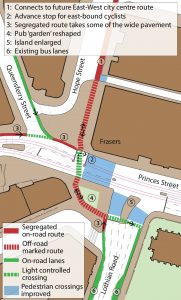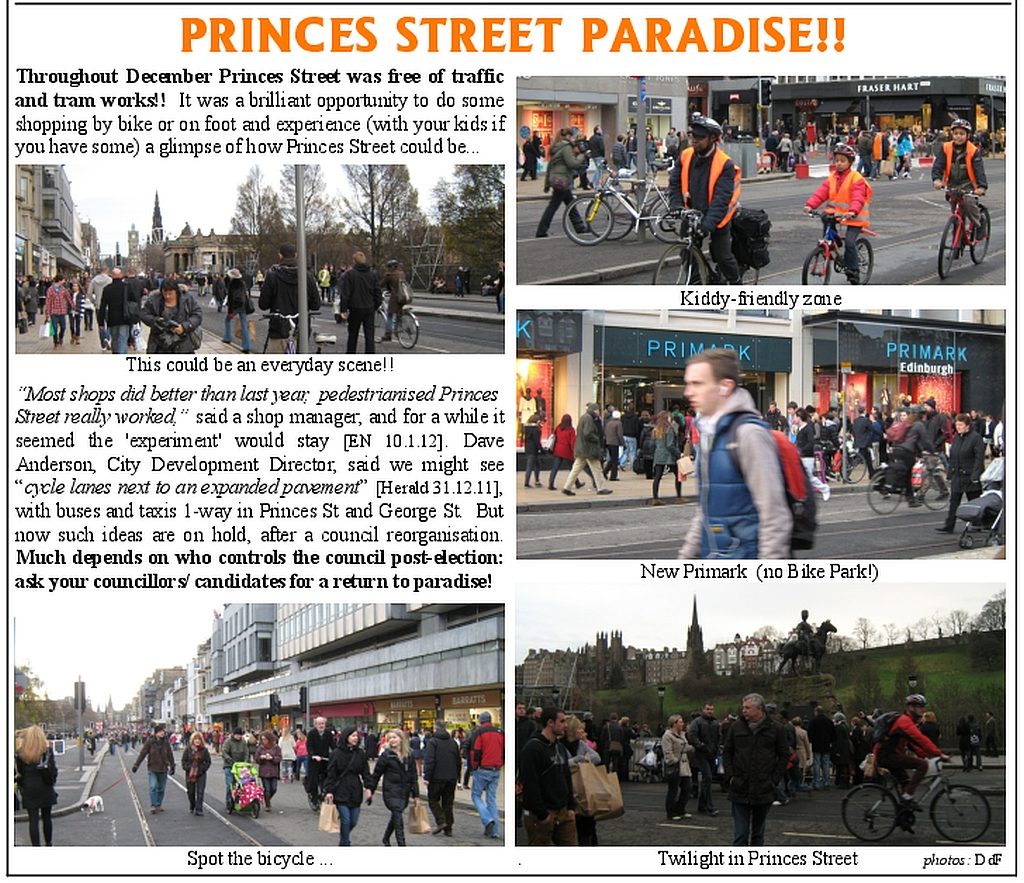[Later: 9.6.17 Article from Local Transport Today fortnightly magazine for transport professionals]
The tragic death of Edinburgh University medical student Zhi Min Soh at the West End junction has highlighted the dangers of tramlines and of that junction for people getting around by bike.
Spokes, along with every traveller, is distressed at the dreadful death of someone making the kind of journey we all make every day, only to be caught in a road crash tragedy. Our thoughts are with family and friends.
A one-minute silence in memory of Zhi Min Soh, and to call for safer conditions, was organised at the West End junction on Wednesday 7 June at 8.30a.m. Some photos from Chris Hill are here.
This article aims to provide some background to the tramline design and what has been and could be done to improve tramline/bike safety.
At the outset, it is important to recognise some facts…
- The exact cause of Zhi Min Soh’s crash is not known. Whilst eyewitnesses and the press have stated it was caused by a wheel getting caught in the tramlines, we have to await official reports before knowing for certain what did in fact happen.
- There is extensive evidence of the dangers of the tramlines for cyclists and, to a lesser extent, for walkers – for example the medical data collected by Professor Chris Oliver (192 cycling and 53 walking tramline-related injuries treated at the Royal Infirmary). As long ago as 2015 solicitors were already handling nearly 100 claims for damages over tramline-related injuries.
- Solutions to these problems are not simple, particularly given the layout of the tramlines (see below)
- Whilst the Council should undoubtedly have done much more to tackle the problems, it is wrong to say they have done nothing important – the number of crashes at the worst blackspot by far, outside Haymarket Station, has been cut significantly (see below).
- People frequently suggest use of plastic or other tramline ‘fillers.’ We understand that Edinburgh Trams has investigated a variety of makes and not found any which are effective, can withstand tram wheel pressure, and, most importantly, which work on the type of rail used in Edinburgh’s onroad tram sections (there are successful options for offroad sections). See our Spokes note on tramline fillers. If anyone knows of fillers which do work well in this type of rail, please contact Edinburgh Trams.
BACKGROUND – TRAMLINE LAYOUT
Many of today’s tramline crash problems result from the layout of the tramlines. Ten years ago, when the layout was being decided Spokes, supported by TIE (the Council agency which ran the trams project), brought over a Dutch transport expert, Hans van der Stok, of Goudappel Coffeng consultancy. Van der Stok spent 2 days studying the initial plans for Princes Street/ Leith Walk area. His November 2007 report is here.
Van der Stok concluded that it was possible and important to provide segregated cycle lanes, either two-way at one side of the road or two one-way lanes. He also pointed out (4.1) that the proposed central island between the tramlines meant a waste of a precious 1.5m of road width, which could alternatively be used for additional cycle and/or pedestrian space.
In discussion with Spokes, van der Stok made clear that design in the Netherlands would have to be holistic from the outset – the design would have to pay full and equal consideration to tram, bus, cycle, walk. In contrast, in Edinburgh, the impression was to design a tramline and then fit everything else in as best could be done – this was perhaps partly because government funding for the tram project was under threat and so the Council was under great pressure to design the scheme rapidly.
Despite the van der Stok study being partially funded by TIE, its main recommendations were rejected. As far as we could tell, a deciding factor was that TIE considered it essential to retain the 1.5m central island in Princes Street and Leith Walk – as we recall, one of the main reasons given was concern that without central traffic lights not all drivers would be able to see the traffic signals, due to the road widths.

Official opening ride for Princes Street cycle lanes in 1996. The lanes were removed some 10 years later, thanks to the tramline layout design.
Indeed, TIE’s tramline layout even meant removing the existing Princes Street (non-segregated) cycle lanes.
Although not mentioned in the van der Stok report, in addition to the central island, there are other locations (e.g. Haymarket and West End) where the tramlines diverge from each other further than seems necessary, again cutting down on the precious space between kerb and tramline where safe cycle provision is required.
A Spokes article from 2013 with more about the background, as we saw it, is here.
Given the tramline layout as it is, subsequent councils have had to do the best they can with that legacy.
OUTSIDE HAYMARKET STATION
Initially this was the worst blackspot, with roughly as many crashes reported to Spokes here as in the remainder of the tram system combined. Perhaps for that reason, and also because remedial measures were relatively simple, the Council has acted. First, the taxi rank was quickly relocated since, despite police action, taxis were consistently parking illegally, forcing cyclists to dismount or hit the tramlines at very poor angle.
Whilst this helped greatly, crashes were still frequent. Our suggested long-term solution was not accepted, but could form a future extension to the east-west route. However, the Council next installed a very brightly coloured cycle lane, indicating the safest route under the existing layout. Somewhat to our surprise, reports (to Spokes) of crashes here have fallen greatly, whilst they continue unchanged elsewhere. Many cyclists do not use the entire lane, but perhaps it concentrates attention onto the danger. However, the coloured lane is not a complete solution and – importantly – although it is quite effective in the particular circumstances of Haymarket, where you are on the left of all traffic, the same solution is unlikely to help at most other danger points, where separation is the clearest answer.
WEST END JUNCTION
This is a far more complex problem, with several danger points, restricted space, much bus and coach traffic, and significant private traffic at peak times. The worst manoeuvre is when turning right from Lothian Road and wishing to continue eastbound along Princes Street – you can be turning as you cross the tramlines, with traffic on one or both sides, and with little chance to cross all the 4 lines at a good angle.
There is no simple solution, but Spokes put forward an option for discussion in Bulletin 123. A cyclist travelling from Lothian Road to Princes Street eastbound would follow the numbers 6,3,4,2 on the dawing. This would not solve all the problems, it entails a slight delay on some trips, and would probably not be used by confident cyclists willing to risk the above on-road manoeuvre. However it also speeds up some other trips and certainly appears much safer. This option could tie in well with Council plans for the east-west route (see below).
Another (or combined) option would be advance traffic lights, allowing the cyclist a few precious seconds to cross the tramlines before motor traffic – though of course it would only work for those cyclists already at the stop line when green begins.
A fuller solution would begin with segregated cycle provision all along the wide Lothian Road, and measures to further reduce private motor traffic in the city centre – a process already underway but needing speeded up. The fact that peak-period city centre car traffic appears to be in long-term decline should make it politically easier to install segregated provision.
WHAT NEXT?
Although the Council has looked at danger points all along the tram route, and has identified possible amelioration measures, nothing has been done on the ground except at Haymarket. We believe this is due to a combination of…
- staff shortages and reorganisation in recent years (hopefully now largely complete)
- insufficient political imperative, including to re-allocate roadspace
- the time-consuming consultation and legal work involved in traffic management changes.
However following the death of Zhi Min Soh, Cllr Adam McVey, the former Deputy Transport Convener, and likely soon to be the new Leader of Edinburgh City Council, has said …
“I’ve spoken to senior officers about their immediate plans to improve cyclist safety, particularly on Princes Street, and about how we can accelerate some plans already in the pipeline to help improve safety for those on bikes across the city.”
We suggest the following…
- General – the Council should take a stronger line in support of roadspace re-allocation away from motor traffic (particularly private car, moving or parked) and towards cycling and walking.
- Staffing – We appreciate that our proposals below could have significant staffing implications. Following a PQ by Alison Johnstone MSP, the Transport Minister and First Minister expressed their wish to assist in safety improvements – we hope discussions will include assisting the council to ensure adequate staffing to achieve effective outcomes as quickly as possible, if this is indeed a sticking point.
- West End Junction – the Council’s existing East-West cycleroute plans include (not in the first phase) a cycle crossing of Shandwick Place linking Lothian Road/Rutland Square with Hope Street/ Charlotte Square. This link should become a top priority (it has value far beyond the east-west route) and should take into account our suggestions (above) from Bulletin 123.
- Entire existing on-street tramline – council plans for all danger spots must be revisited and implemented.
- Tramline extension – cycling and walking must be designed in from the outset, in a holistic way, rather than being an add-on once tramline decisions have been finalised.
- Princes Street – to our disappointment, none of the political parties except the Greens promised any action on Princes Street in their council election manifestos. Nonetheless, the new Council should undertake to redesign Scotland’s iconic street, the heart of Edinburgh, into a more people-friendly place which incorporates segregated cycle provision. Note that tramline crashes occur not just at junctions, but often too when a cyclist travelling parallel to the lines is forced by traffic pressures to move sideways, meeting the tramlines at a very bad angle – segregated cycle provision would eliminate this problem entirely. The planned George Street cycleroute is not an alternative – it will be valuable for many trips, but for many others it is not a realistic alternative to Princes Street.


